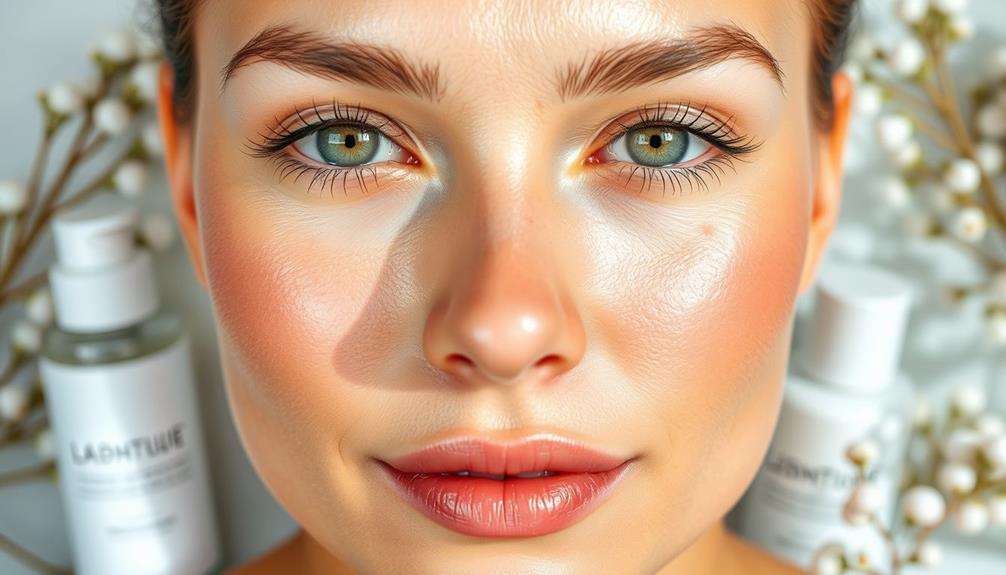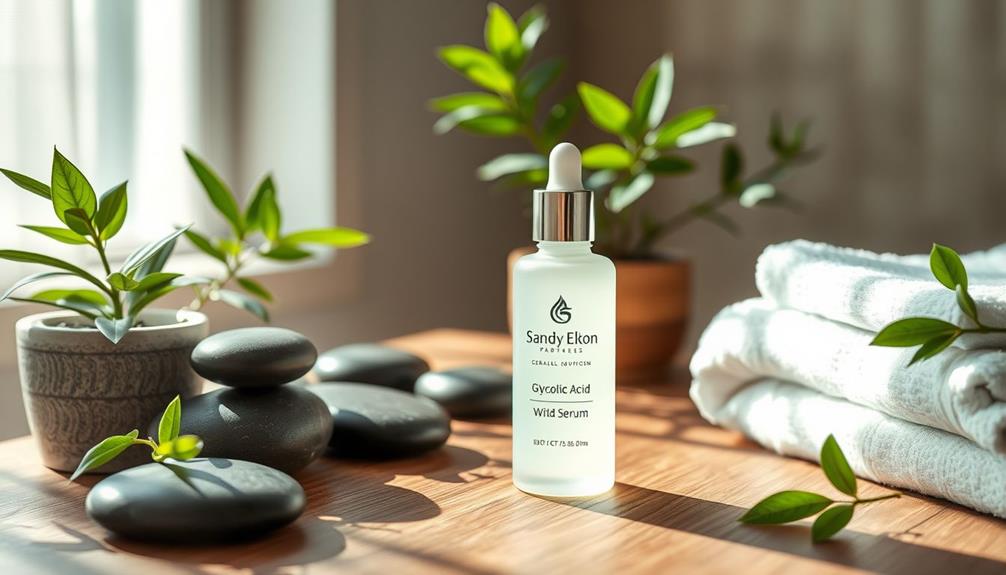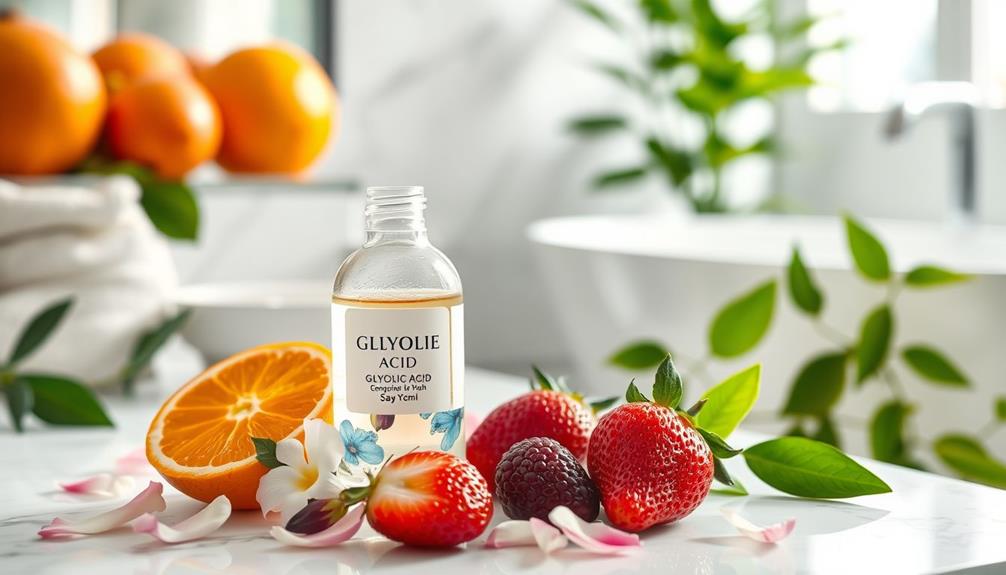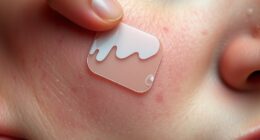Glycolic acid effectively manages keratosis pilaris by promoting exfoliation and enhancing skin texture. It works by breaking down keratin buildup in hair follicles, helping to shed dead skin cells and reduce rough bumps. Regular use not only smooths your skin but also boosts cell turnover, leading to a brighter, healthier appearance. Plus, it greatly improves hydration levels, making your skin feel softer. For the best results, consider combining glycolic acid with other treatments. If you'd like to explore how to integrate this powerful acid into your routine, there's much more to discover!
Key Takeaways
- Glycolic acid promotes exfoliation, breaking down keratin buildup and helping to shed dead skin cells associated with keratosis pilaris.
- Regular use of glycolic acid improves skin texture, reducing the appearance of rough bumps and enhancing overall skin brightness.
- As an alpha-hydroxy acid, glycolic acid penetrates deeply, increasing skin cell turnover and minimizing keratin plugs.
- Dermatologists recommend glycolic acid for its dual benefits of exfoliation and hydration, leading to visible improvements in skin condition.
What Is Keratosis Pilaris?
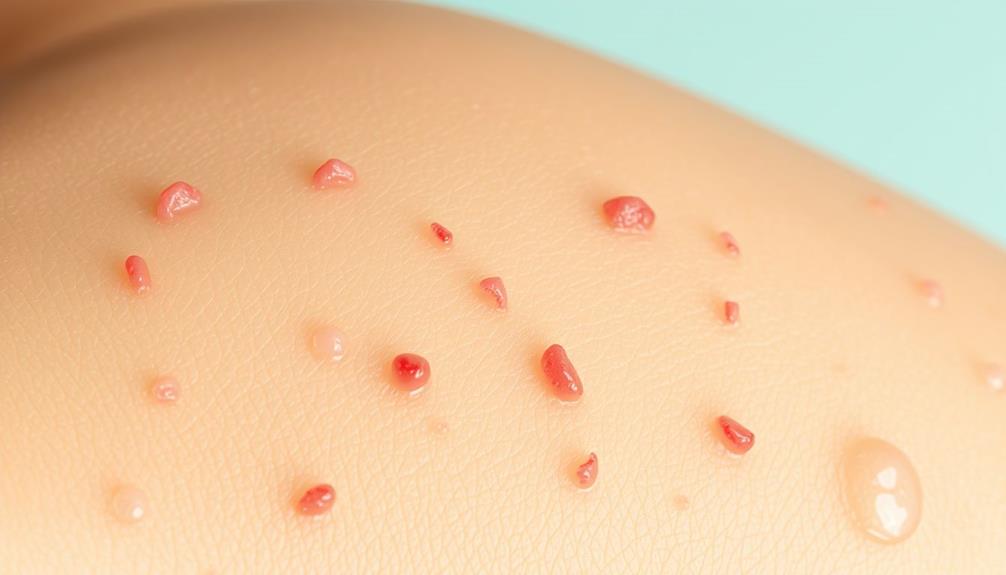
Keratosis pilaris (KP) is a common skin condition that manifests as small, rough bumps resembling "chicken skin" on areas like your upper arms and thighs.
These rough bumps occur due to the buildup of keratin, a natural protein that forms keratin plugs in hair follicles. This skin condition affects a significant portion of the population, with around 50-80% of adolescents and adults experiencing it at some point.
Curiously, while KP is primarily a skin concern, incorporating essential oils like lavender oil may provide soothing benefits for the skin.
You'll notice that KP typically presents as painless red or white bumps, which can feel dry or rough to the touch.
Factors like dry weather, skin conditions, or even a family history of dry skin, asthma, or eczema can exacerbate the appearance of these bumps.
While keratosis pilaris is harmless and not contagious, many people seek treatment to improve their skin's appearance, as it can lead to cosmetic concerns.
Understanding what keratosis pilaris is can help you determine the right approach to manage it.
With this knowledge, you can explore effective treatments, including topical solutions that address the underlying keratin buildup.
Role of Glycolic Acid
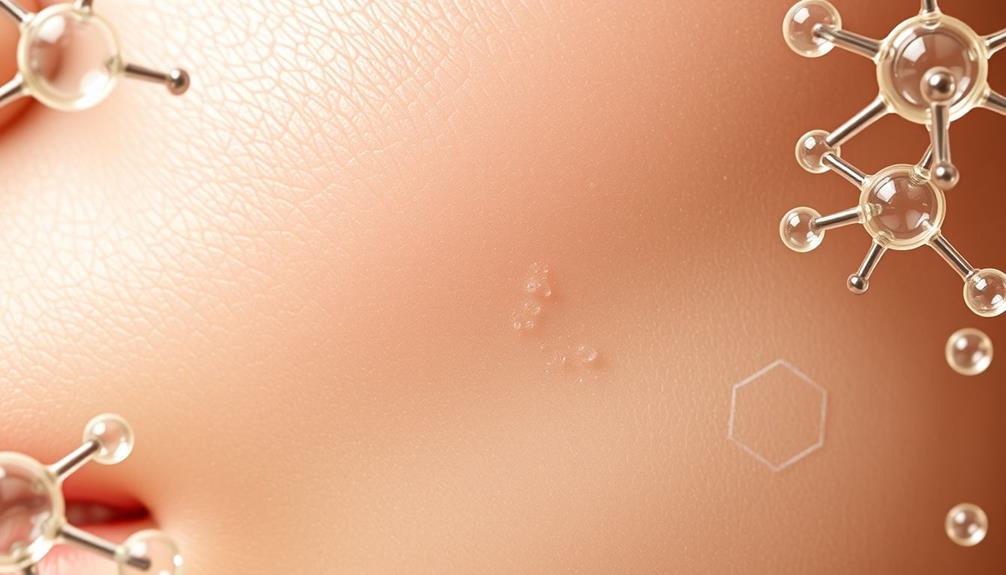
Glycolic acid plays an essential role in managing keratosis pilaris by promoting exfoliation and improving your skin's texture.
It works by breaking down keratin buildup, allowing dead skin cells to shed easily and revealing smoother skin beneath.
Additionally, incorporating essential oils for skin health can further enhance your skincare routine.
As you incorporate glycolic acid into your routine, you'll likely notice a significant enhancement in your skin's overall appearance and feel.
Exfoliation Mechanism Explained
By breaking down the bonds between dead skin cells, glycolic acid effectively promotes exfoliation and helps clear the keratin buildup associated with keratosis pilaris.
As the smallest alpha-hydroxy acid (AHA), glycolic acid penetrates deeply into your skin, making it especially effective. When you apply glycolic acid, it encourages the shedding of the outer layer of skin, allowing fresh, new cells to emerge.
This process not only reduces the rough bumps typical of keratosis pilaris but also enhances your skin's overall texture. With regular use, glycolic acid increases skin cell turnover, which means damaged cells are replaced more quickly. You'll notice that the appearance of keratin plugs diminishes, leading to smoother skin.
Moreover, studies have shown that consistent application of glycolic acid can considerably improve skin smoothness and brightness for those dealing with keratosis pilaris.
Skin Texture Improvement
Improving skin texture is one of the key benefits you'll experience with the regular use of glycolic acid, as it effectively smooths the roughness caused by keratosis pilaris.
This small alpha-hydroxy acid penetrates deeply into your skin, breaking down the keratin buildup associated with KP. By promoting cell turnover, glycolic acid accelerates the exfoliation of dead skin cells, leading to a more refined and even skin texture.
Incorporating a holistic lifestyle approach, including stress management techniques, can further enhance the health of your skin during this process.
As you incorporate glycolic acid into your skincare routine, you'll likely notice a significant reduction in the bumpy appearance of your skin.
The acid weakens the bonds between dead skin cells, making it easier for keratin plugs to be removed from hair follicles. This process not only helps clear up the rough patches but also enhances skin brightness and clarity.
With consistent use, glycolic acid can lead to long-term improvement in your skin's overall texture.
You'll find that your skin feels smoother and looks healthier, making glycolic acid an essential component for managing keratosis pilaris effectively.
Benefits of Glycolic Acid
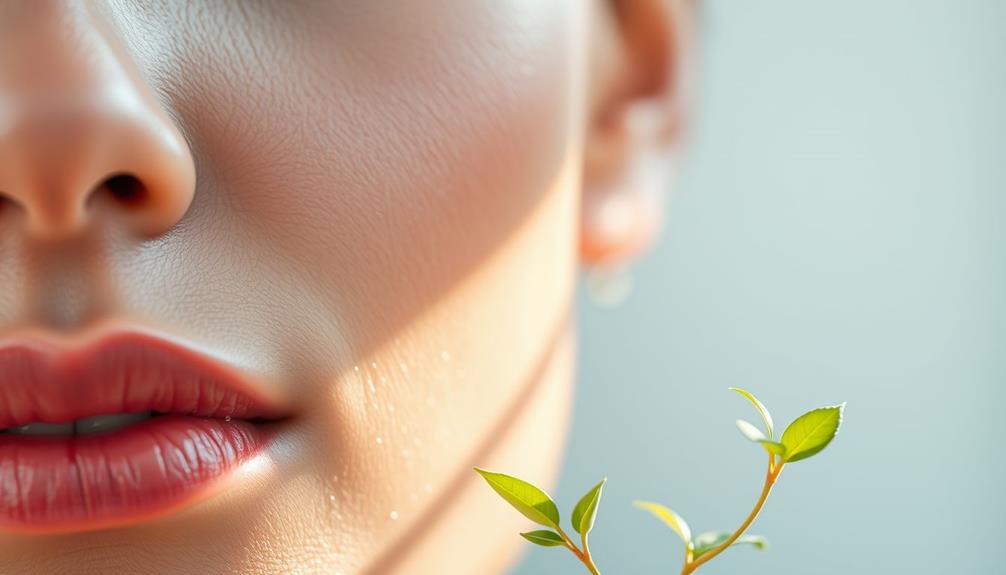
Using glycolic acid can transform the skin's texture, effectively reducing the rough bumps associated with keratosis pilaris.
This powerful alpha-hydroxy acid (AHA) works by breaking down excess keratin, which is the primary cause of those pesky bumps.
Since glycolic acid is the smallest AHA, it penetrates deeply into the skin, promoting effective exfoliation and enhancing overall skin texture.
Additionally, maintaining a clean air environment with products like ozone air purifiers can further support skin health by reducing allergens that may exacerbate skin conditions.
Regular use of glycolic acid not only smooths the skin but also brightens it, as it facilitates cell turnover and keeps pores from clogging.
You'll notice that the appearance of keratosis pilaris diminishes with consistent application, leading to visible improvements in both texture and pigmentation.
Many dermatologists recommend glycolic acid as a go-to treatment for managing keratosis pilaris due to its dual benefits of exfoliation and hydration.
When you incorporate glycolic acid into your skincare routine, you're taking a significant step towards achieving smoother, healthier skin.
Mechanism of Action

Glycolic acid works by penetrating deeply into the skin to break down the bonds between dead skin cells, making it effective in treating keratosis pilaris.
This small alpha-hydroxy acid (AHA) performs a keratolytic action, which helps reduce keratin buildup in hair follicles—a primary cause of KP.
By promoting exfoliation, glycolic acid helps to clear away the rough bumps and smoothens your skin texture.
As you regularly apply glycolic acid, you'll notice an increase in cell turnover.
This means your skin sheds its dull, dead layers more efficiently, leading to a brighter and more even skin tone.
The exfoliation process not only targets the visible symptoms of keratosis pilaris but also addresses its root cause, making it a popular choice among dermatologists for managing this condition.
With continued use, glycolic acid can considerably diminish the appearance of those pesky bumps and improve overall skin health.
Recommended Glycolic Acid Products
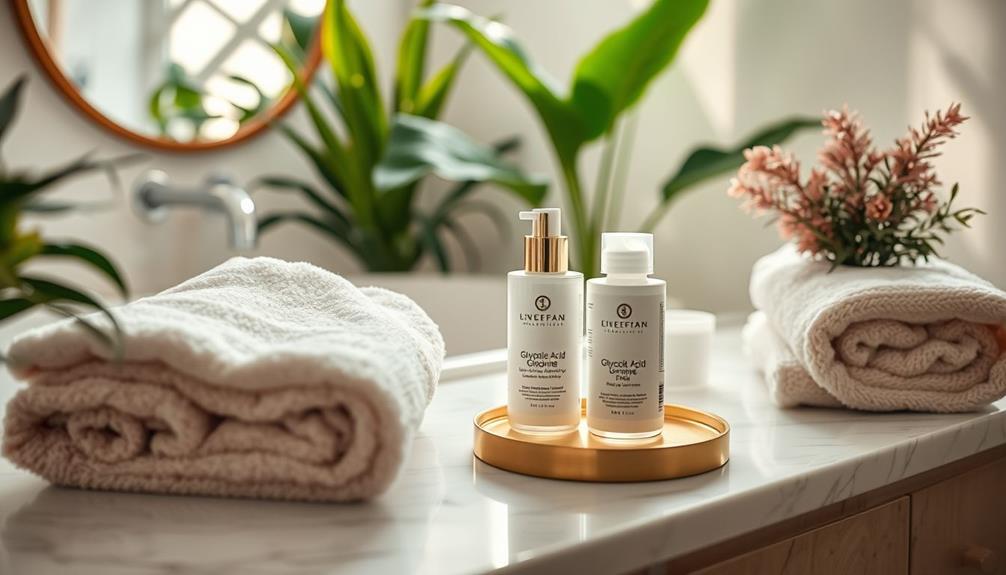
Finding the right glycolic acid product can make a significant difference in managing keratosis pilaris and achieving smoother skin. One standout option is The Ordinary Glycolic Acid 7% Toning Solution, which effectively breaks down excess keratin and improves skin texture for just $8.70.
If you prefer a combination approach, Paula's Choice Weightless Body Treatment, priced at $32, offers a lightweight formula with 2% salicylic acid, ideal for exfoliating and smoothing rough patches.
For a moisturizing touch, consider AmLactin Ultra Smoothing Cream at $16, which combines gentle exfoliation with hydration—perfect for use after your shower.
If you're looking for convenience, Tula Exfoliating Pads, available for $36, provide an easy way to incorporate glycolic acid into your routine, only needing to be used 1-2 times a week.
Lastly, the Glytone KP Kit, currently $40 (down from $75), includes both an exfoliating body wash and lotion specifically formulated to tackle keratosis pilaris with glycolic acid.
Choosing the right product tailored to your needs can help you effectively manage keratosis pilaris and enhance your skin's overall texture.
Application Tips for Glycolic Acid
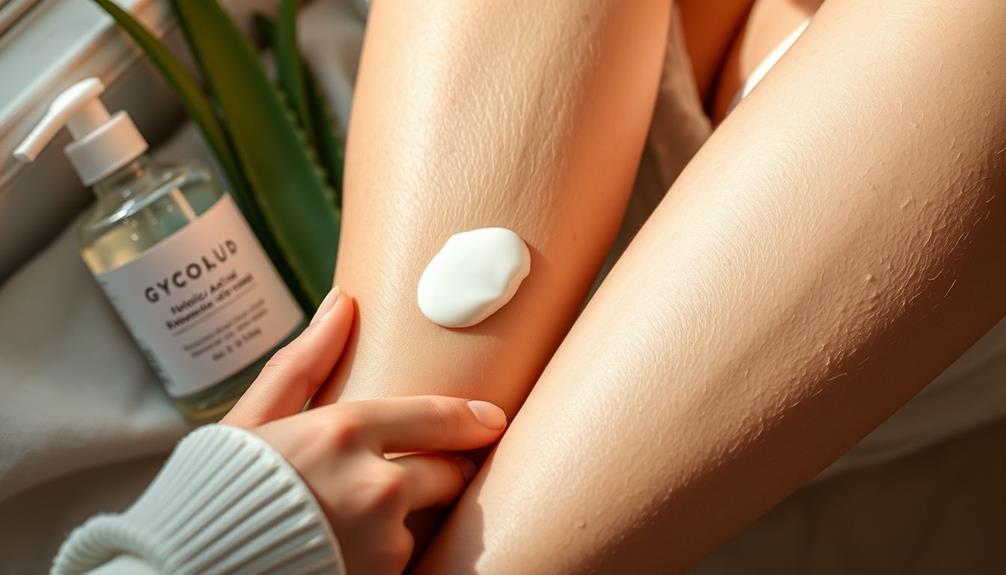
To get the most out of glycolic acid products for keratosis pilaris, it's important to apply them correctly for maximum effectiveness. Start by cleansing your skin and ensuring it's completely dry, which allows for better absorption of the glycolic acid. Begin with a lower concentration (5-7%) and gradually increase as your skin tolerates it. Use these treatments in the evening to reduce sun sensitivity, and initially, apply glycolic acid every other day to avoid irritation.
Here's a quick reference table for your application routine:
| Step | Action | Frequency |
|---|---|---|
| Cleanse | Wash your skin thoroughly | Daily |
| Apply Glycolic Acid | Use a small amount on dry skin | Every other day |
| Apply Moisturizer | Follow up to hydrate your skin | Daily |
Expected Results and Improvements

With regular use, you can expect noticeable improvements in the texture and appearance of your skin within just a few weeks. Glycolic acid effectively exfoliates, breaking down dead skin cells that contribute to the bumps associated with keratosis pilaris. As you incorporate glycolic acid into your skincare routine, you'll likely see smoother skin and a reduction in the visibility of those pesky bumps.
Many users report significant enhancements in skin brightness and overall appearance. You'll notice that rough patches soften, and the size and redness of keratosis pilaris bumps decrease. Clinical studies support these findings, showing that glycolic acid treatments can improve hydration levels, promoting a healthier skin barrier.
Long-term use of glycolic acid not only helps with immediate improvements but also aids in maintaining smoother skin and preventing future keratin buildup. This ongoing management of keratosis pilaris symptoms means that you can enjoy clearer, more radiant skin over time.
Safety and Precautions
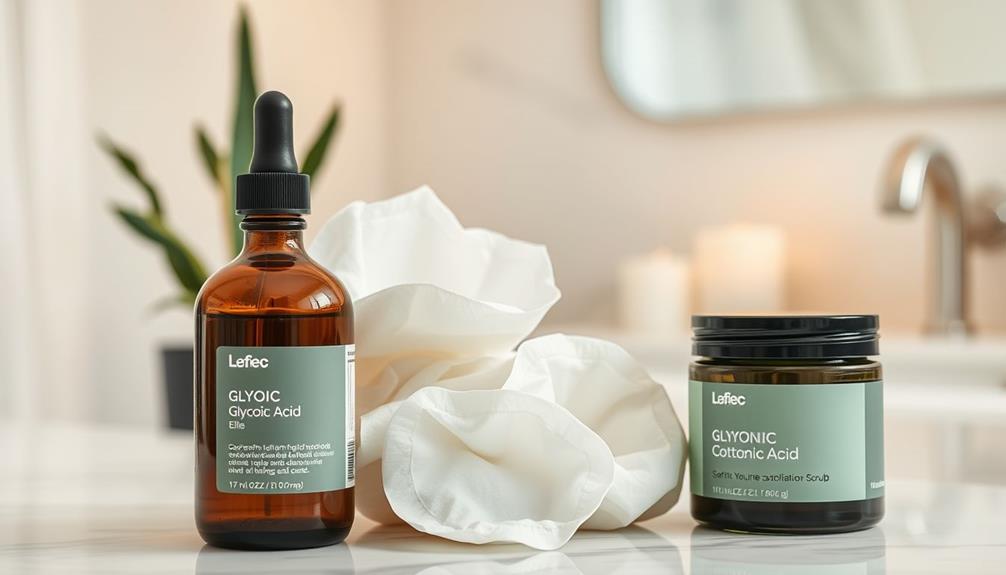
Glycolic acid is safe for most skin types, but if you have sensitive skin, it's wise to perform a patch test to gauge your tolerance. This simple step can help you avoid potential reactions and guarantee your safety when using glycolic acid.
Start with lower concentrations and gradually increase usage to minimize the risk of over-exfoliation, which can irritate the skin, causing dryness or redness.
When incorporating glycolic acid into your routine, remember to use it a few times a week, especially if you're new to chemical exfoliants. This allows your skin time to adjust and prevents excessive irritation.
Additionally, daily sunscreen application is vital, as glycolic acid can increase your skin's sensitivity to UV rays, raising the risk of sunburn.
Avoid combining glycolic acid with other strong actives like retinoids unless guided by a dermatologist. This precaution helps maintain your skin's safety and prevents overwhelming it with too many exfoliating agents.
Combining Glycolic Acid With Other Treatments
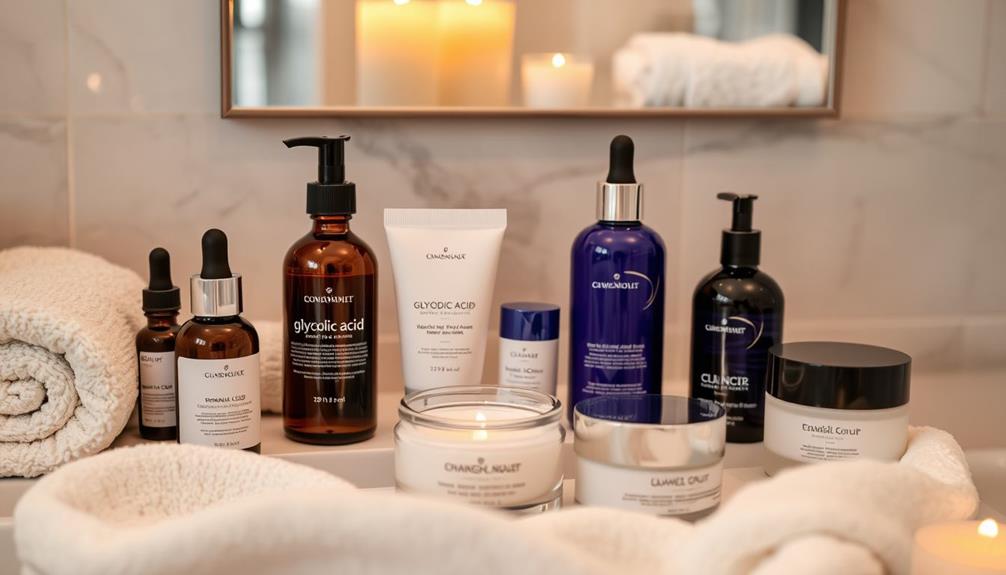
When you're treating keratosis pilaris, combining glycolic acid with other effective ingredients can really boost your results.
You might find that layering treatment strategies and paying attention to timing enhances your skin's texture and smoothness.
Let's explore how these complementary approaches can work together for better outcomes.
Complementary Ingredients for KP
Combining glycolic acid with other effective ingredients can greatly enhance your treatment for keratosis pilaris (KP). For instance, pairing glycolic acid with lactic acid boosts exfoliation while providing hydration, helping you manage KP without excessive dryness. Similarly, salicylic acid penetrates deeper into your pores, reducing keratin buildup and preventing clogged follicles that contribute to KP.
Urea is another powerful ally. When mixed with glycolic acid, it acts as an emollient that softens the skin and breaks down keratin plugs, improving overall texture.
Here's a quick reference table for these complementary ingredients:
| Ingredient | Benefit |
|---|---|
| Glycolic Acid | Exfoliates dead skin cells |
| Lactic Acid | Hydrates while enhancing exfoliation |
| Salicylic Acid | Deeply penetrates to clear clogged follicles |
| Urea | Softens skin and breaks down keratin plugs |
Incorporating these ingredients into your routine can considerably improve your skin's texture and appearance. Always remember to follow up with a soothing moisturizer to help maintain your skin barrier.
Layering Treatment Strategies
Layering glycolic acid with other treatments can greatly enhance your approach to managing keratosis pilaris by improving exfoliation and overall skin texture.
Combining glycolic acid with keratolytics like salicylic acid or lactic acid can considerably boost exfoliation, helping to smooth out those pesky bumps. Start your skincare routine with glycolic acid to effectively soften keratin plugs, paving the way for better absorption of other products.
Incorporating moisturizers containing urea can provide dual benefits, offering both exfoliation and hydration. This is vital for preventing the dryness often associated with keratosis pilaris treatments.
You might also consider gentle physical exfoliation methods, such as using a loofah or washcloth, after applying glycolic acid. This can enhance the removal of dead skin cells and further reduce the visibility of bumps.
To avoid irritation, remember to alternate glycolic acid treatments with soothing moisturizers. Keep an eye on how your skin responds before ramping up the frequency.
Timing and Application Tips
To achieve the best results with glycolic acid, apply it after exfoliating to effectively break down keratin plugs and enhance the absorption of other treatments.
Start by using exfoliating pads to prepare your skin. This helps glycolic acid penetrate better, allowing it to work its magic on keratosis pilaris.
For peak results, use glycolic acid products at night. This timing allows your skin to regenerate without the risk of sun exposure, which can cause irritation.
Begin with a lower concentration, around 5-7%, to assess your skin's tolerance. Once you're comfortable, you can gradually increase the concentration up to 10%.
Combining glycolic acid with moisturizers or hydrating ingredients, like urea, can help improve your skin's moisture levels and minimize dryness.
If you're also using other active ingredients, such as retinoids or salicylic acid, alternate their use. This approach prevents over-exfoliation and irritation, ensuring your skin stays healthy while you tackle keratosis pilaris.
Following these timing and application tips will maximize the benefits of glycolic acid in your skincare routine.
Long-Term Management Strategies
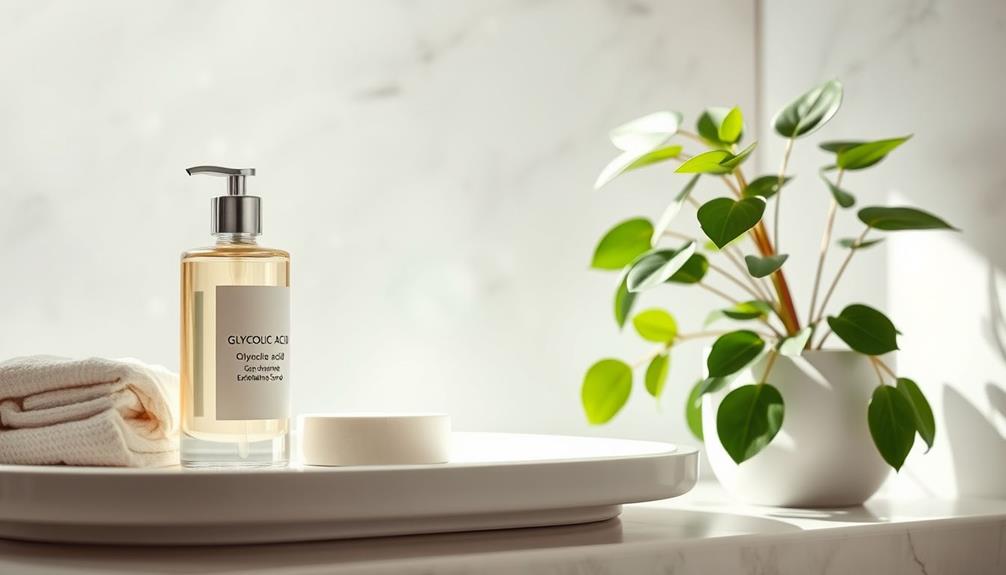
Regularly incorporating glycolic acid into your skincare routine can effectively manage keratosis pilaris over the long term. This alpha-hydroxy acid promotes the exfoliation of dead skin cells, preventing keratin buildup that leads to those pesky bumps.
By using glycolic acid products like toners or lotions 1-2 times a week, you'll enhance your skin's texture and smoothness, which is crucial for long-term management of KP.
Don't forget to combine glycolic acid with moisturizing agents. This combination helps to manage dryness and irritation, keeping your skin hydrated while treating keratosis pilaris effectively. Hydration is key, as it allows the glycolic acid to work without causing unnecessary discomfort.
Keep an eye on how your skin responds to glycolic acid. Adjusting the frequency of application can help you find the perfect balance, minimizing the risk of over-exfoliation while maximizing the benefits.
With consistent use and proper hydration, you'll be well on your way to managing keratosis pilaris and enjoying smoother skin in the long run. Remember, patience is essential in this journey, and results will come with time.
Conclusion
Incorporating glycolic acid into your skincare routine can be a game-changer for tackling keratosis pilaris.
Imagine effortlessly transforming your skin from bumpy to beautifully smooth, as if you've discovered a fountain of youth!
With its powerful exfoliating properties, glycolic acid doesn't just improve texture; it revolutionizes your skin's appearance.
Embrace this potent ally, and watch as your confidence skyrockets, leaving your skin radiant and radiant—because you deserve nothing less than perfection!
